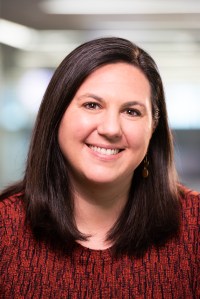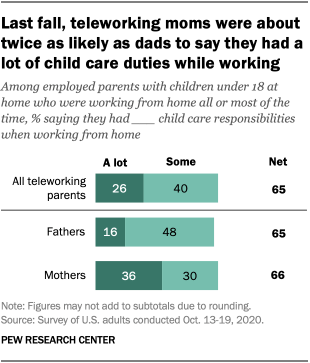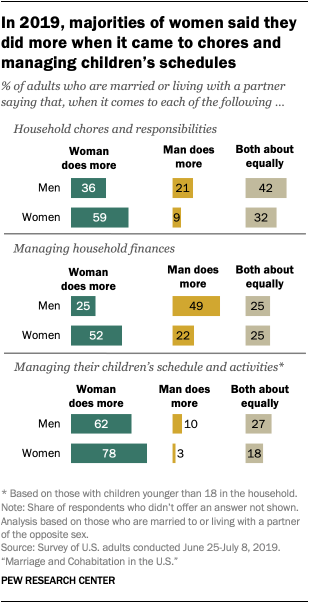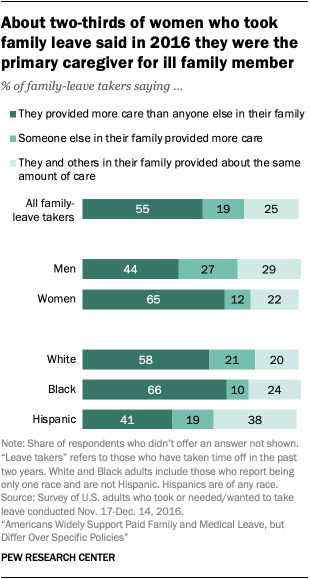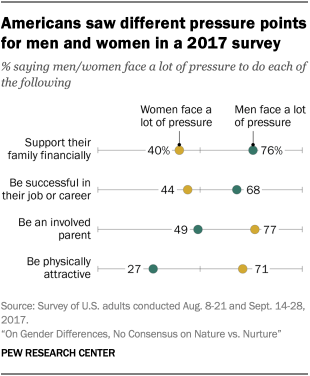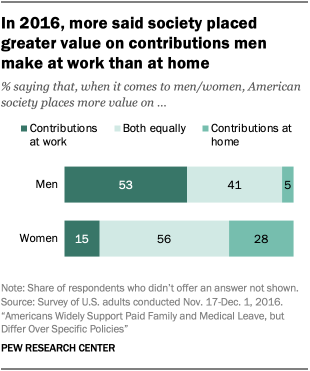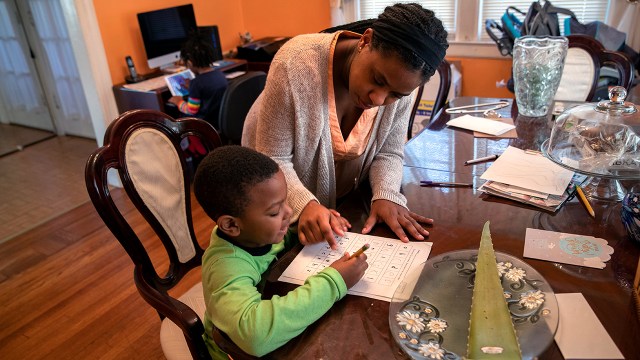
The COVID-19 pandemic has presented challenges and obstacles for many Americans, but one group has been getting a lot of attention lately: moms. Much of the focus has been on the effects of school closings and child care responsibilities on mothers’ employment and labor force participation rates, with some suggesting the disruptions caused by the pandemic might have long-lasting consequences for gender equality in the workplace. In response, many prominent public figures have signed on to the Marshall Plan for Moms, which calls on Congress to recognize mothers’ unpaid labor at home through monthly stimulus checks alongside paid family leave, affordable child care and pay equity programs.
Pew Research Center surveys have highlighted some of the unique challenges facing moms during the pandemic. For example, a survey last October found that, among employed parents who were working from home all or most of the time, mothers were more likely than fathers to say they had a lot of child care responsibilities while working (36% vs. 16%). Working mothers with children younger than 12 at home were also more likely than fathers (57% vs. 47%) to say it had been at least somewhat difficult for them to handle child care responsibilities during the coronavirus outbreak.
This analysis is a roundup of Pew Research Center survey findings that mostly predate the coronavirus pandemic. Links are provided in the text for readers interested in learning more about the findings and methodologies of each survey, including field dates, sample sizes and the exact questions asked.
But these dynamics aren’t new. Before the pandemic began in March 2020, women were already more likely than their spouses or partners to say they carried more of the load when it comes to both parenting and household responsibilities. In addition, working moms were more likely than working dads to say they faced certain challenges at work because they were balancing work and family responsibilities.
Work and family
In a summer 2019 survey, employed moms (50%) were more likely than employed dads (39%) to say being a working parent made it harder for them to advance in their career. Working moms were also more likely than dads to say there had been times where they needed to reduce their work hours (54% vs. 44%) and felt like they couldn’t give 100% at work (51% vs. 43%) because they were balancing work and parenting responsibilities.
Roughly a quarter (27%) of working moms said they were treated as if they weren’t committed to their work, compared with 20% of dads. Around one-in-five working moms (19%) said they’d been passed over for an important assignment or a promotion because they have children, compared with smaller shares of dads.
Similar patterns and gender differences were evident in October 2020, when working parents were asked if they had had these experiences since the beginning of the coronavirus outbreak.
Division of labor
The challenges of the pandemic have raised to the surface questions about the division of household chores and responsibilities among couples, particularly as many schools and day care centers remain closed. But even before the pandemic, about six-in-ten women in opposite-sex relationships (59%) said they did more than their spouse or partner when it came to handling these responsibilities, while just 9% said their spouse or partner did more. Roughly a third (32%) said they shared household chores and responsibilities about equally with their spouse or partner.
In the same survey, roughly eight-in-ten moms (78%) said they did more than their spouse or partner when it came to managing their children’s schedules and activities – and 62% of fathers agreed that their spouse or partner did more in this regard.
Again, these patterns emerged when married and cohabiting adults in opposite-sex relationships were asked the same questions in October 2020, several months into the pandemic.
Caregiving
Caregiving comes in many forms, whether it’s taking care of a new child or a sick family member. In a 2016 Pew Research Center survey, 65% of women who had taken time off from work to care for a family member with a serious health condition in the two years prior to the survey said they had provided more of the care than anyone else in their family. Among men who had taken family leave, by comparison, 44% said they had provided more care than anyone else.
Perceptions around caregiving also differed between men and women. In the same survey, 45% of Americans said that when a family member has a serious health condition, caregiving responsibilities fall mainly on women. Women (59%) were far more likely than men (29%) to say this; 69% of men said these responsibilities fall on both men and women equally.
Perceptions differed not only in terms of who does the caregiving, but who does it better. When it comes to caring for a family member with a serious health condition, a majority of adults (59%) said men and women would do about an equally good job, but a substantial share (40%) said women would generally do a better job than men. Women were more likely than men to say women would do a better job (45% vs. 34%). Just 1% of U.S. adults said men would do a better job than women.
When it comes to parenting, a larger share of Americans said that, aside from breastfeeding, mothers would do a better job caring for a new baby than said both mothers and fathers would do about an equally good job (53% vs. 45%). The view that mothers would do a better job than fathers caring for a new baby was more common among men than women (56% vs. 50%).
Societal expectations
In 2020, a majority of Americans said the country hadn’t gone far enough in giving women equal rights with men, and among that group, some 66% said different societal expectations for men and women were an obstacle.
How do these societal expectations differ? On a basic level, Americans see different pressures for men and women. In a 2017 survey, most U.S. adults said women face a lot of pressure to be an involved parent (77%) and to be physically attractive (71%), while smaller shares said men face a lot of pressure in each of these areas (49% and 27%, respectively). In turn, Americans were far more likely to say men experience a lot of pressure to support their family financially (76% vs. 40% who said women face a lot of pressure in this area) and to be successful in their job or career (68% vs. 44% who said this about women).
These pressures are reflected in the expectations generally ascribed to men and women and where they are expected to thrive. In 2016, some 53% of adults said American society places more value on the contributions men make at work, while 41% said society values the contributions men make at work and at home about equally and just 5% said society values men’s contributions at home more. When asked about what society values more when it comes to women, 15% pointed to the contributions they make at work, while 56% said society values women’s contributions at work and at home about equally and 28% pointed to the contributions women make at home.
